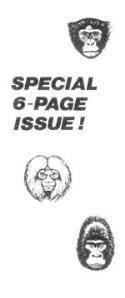The
word that mighty towns and anxious villages all over the world have been
waiting and hoping for was flashed yesterday across television screens,
computer terminals and radio dials everywhere to the accompaniment of a
rising crescendo of congratulations and good wishes. Teletypes and
fax machines overheated and at least one satellite failed in a futile attempt
to satisfy the demand for information as the news spread about Professor
Mitsuo Ohhohoho, who was found alive at last by an international search
team only two miles from where he disappeared last year. The end of the
most celebrated missing persons case since Lindbergh's baby came with stunning
swiftness as the find was announced by Senhor Teófilo Afonso Rosario
Sobradinho. The Brazilian primatologist had been seeking the whereabouts
of his friend and mentor ever since he failed to return to the Urubupunga
Research Station, situated on the wandering banks of the sluggish Carauari
River, deep in the heart of the ancient, ant-strewn Amazon.
The professor, author of
Mitsuo's Monkeys and My Life with the Macaques, seemed a bit
befuddled as he stood blinking in the hot sun, festooned with lianas, his
safari jacket torn in two places, and his spectacles slightly askew. He
offered no immediate explanation as to where he had been or what he had
been doing. The search team, which at one time included fifty-seven
people, had shrunk considerably by the time the professor was found. The
group had followed what looked like his trail from Urubupunga to Badongo-Gazimbi
to the Ipululu |



